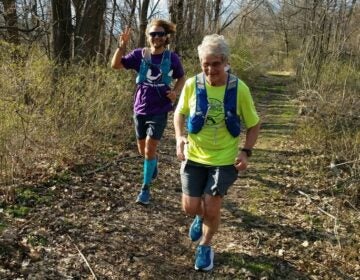The Quinoa Quandary of Princeton
Ten years ago, few of us had heard of quinoa, let alone knew how to pronounce it (KEEN-wah). Now it’s touted as a healthful source of amino acids (proteins) and minerals, ideal for vegetarians and those on a gluten-free diet.
This is part of a series from Ilene Dube of The Artful Blogger.
Ten years ago, few of us had heard of quinoa, let alone knew how to pronounce it (KEEN-wah). Now it’s touted as a healthful source of amino acids (proteins) and minerals, ideal for vegetarians and those on a gluten-free diet.
You can buy it in yellow, red, black or tricolor at stores from Trader Joe’s to Whole Foods; order quinoa salads and quinoa burgers in restaurants; and snack on quinoa chips right out of the bag.
“It’s actually not a grain, it’s a pseudocereal,” says Princeton University senior James Cole, whose exhibition The Quinoa Quandary: A Deconstruction of a Documentary is on view in the university’s James S. Hall ’34 Memorial Gallery in the basement of Yoseloff Hall through April 20.
It took a homework assignment
The art and archaeology major first became interested in the Andean crop a year ago when he was assigned a paper by Professor Alan Mann on the foods of different cultures. Though neither vegetarian nor gluten free, Cole was influenced by his then-girlfriend’s interest in a healthy diet. She also introduced him to the “quinoa quandary”: Over-consumption of the 5,000-year-old cultivar in developing nations was driving up the price of the essential protein so that Bolivians could no longer afford it and were becoming malnourished.
So Cole, a Hopewell, N.J., native, did what any Ivy League junior embarking on a thesis project and wanting to right a wrong would do: He booked a flight to Bolivia.
“When I first started, I wanted to stick it to America,” he says. “In my research I saw that every story was using the same quotes and the story had become sensationalized. But these were not textbook cases, they were living people and I wanted to do primary research and interview them first hand.” He found it the “most fulfilling and profound experience I’d had at Princeton.”
Traveling with a friend who spoke Spanish — Cole does not — he spent two weeks seeing a part of the world that was completely new to him, getting altitude sickness and food poisoning, and photographing the people in their bowler hats and colorful garb with his Canon SLR.
In order to get to the farmers he wanted to speak to, Cole hired a guide and a driver to take him to the farms.
Quinoa is a chenopod in the amaranth family, similar to spinach and beets, he learned. The leaves of the plant are edible, and the nutritious seeds form in panicles. It grows well at high altitudes in a dry sandy soil and doesn’t object to frost. Quinoa’s saponin – a bitter tasting coating that protects it from birds and other predators – requires a labor-intensive rinsing process to make it palatable to humans. When cooked, the seeds become translucent and have a nutlike taste.
Cole found that quinoa really is nutritious, unlike acai, that other newcomer from South American whose dietary claims were proved bogus.
When Cole traveled to Bolivia last summer it was actually winter in the Andes. He was able to photograph the quinoa processing but needed to make a return trip in March to see the crop growing.
Large color prints show everything from rows of quinoa plants in sandy soil, workers spraying in the fields (not all quinoa is organically grown), hand harvesting and cleaning, to a restaurant with heaping plates of quinoa, salad and llama meat, and the crumbling narrow streets of the city. One woman sits at the side of a road, hiding her face with the fringe of her shawl; beside her are sacks of flowers and liter bottles of Coka Quina (Bolivian cola).
A panoramic print nearly four feet wide shows a curved road congested with colorfully clad crowds protesting taxes and high costs. The staggered skyline of La Paz is in the valley behind them. Cole says 100,000 people marched that day, blocking the road so he couldn’t reach the quinoa farms.
“The landscape is dry, arid, expansive and colorless, but the people and shops and quinoa are saturated with color,” he observes.
Deconstructed documentary
The deconstructed documentary of the title is a 10-minute video that consists mostly of close-ups of Cole, unshaven and sometimes out of focus, conveying his personal frustrations with the project. In person, Cole is a confident, good-looking, articulate all American, but in the video he deconstructs, focusing on his anxieties. Speaking in a raspy Heart-of-Darkness voice as the bus he’s in jounces, he describes the mountains and valleys “but I can’t appreciate it because I’m not sure I’ll be home for dinner, and I’ll kick myself when I do get home for not appreciating it at the time.”
“When you get back from a trip, it’s hard to re-create the mental state of when you were there,” Cole says in the gallery, “so I wanted this raw, honest video to provide a counterpoint to the images, a microcosm of the American perspective. Is it possible for a Princeton University student to go to Bolivia and not cast a shadow? The video adds depth to and deconstructs the National Geographic-y photos of peasant farmers. It seems ridiculous to be watching it on a sunny day in Princeton.”
The Artful Blogger is written by Ilene Dube and offers a look inside the art world of the greater Princeton area. Ilene Dube is an award-winning arts writer and editor, as well as an artist, curator and activist for the arts.
WHYY is your source for fact-based, in-depth journalism and information. As a nonprofit organization, we rely on financial support from readers like you. Please give today.




